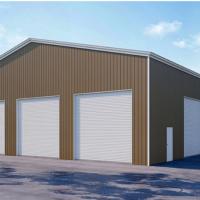Prefab Steel Warehouse Buildings , High Rigidity Steel Frame
Industrial Building
In contrast to traditional buildings, steel structure buildings are
an innovative type of building structural system. These buildings
are entirely constructed using steel materials. The structure is
predominantly made up of components manufactured from section steel
and steel plates, including steel beams, steel columns, and steel
trusses. These components are connected by means of welding,
bolting, and riveting techniques.Thanks to their lightweight nature and uncomplicated construction
process, steel structure buildings have found extensive use in a
wide range of fields, including large industrial plants, sports
complexes, and skyscrapers. The primary types of steel structure
buildings encompass portal frames, frame structures, truss
structures, and space frame structures. Below are the
characteristics and applications of several common steel structure
building types:1,Portal frame structures are characterized by a straightforward
force application principle and a distinct load transfer route.
Additionally, they allow for relatively rapid construction.
Consequently, they are widely adopted in both industrial and civil
construction sectors, covering areas such as industrial workshops,
commercial establishments, and cultural and recreational public
facilities.2,Steel frame structures are highly flexible, which allows for the
creation of expansive interior spaces. They are commonly utilized
in multi-story and high-rise buildings, such as commercial office
buildings, shopping malls, and convention centers.3,Steel truss structures make use of small-section pipes to form
components with larger cross-sectional areas. They are typically
applied in industrial and civil buildings that require large spans
or great heights, such as long-span roofs, bridges, tall towers,
and offshore oil platforms.4,Steel space frame structures are highly complex spatial
structures complex spatial structures composed of numerous rods
arranged in accordance with specific patterns. They have the
advantages of low spatial stress, light weight, high rigidity, and
excellent seismic resistance. As a result, they are ideally suited
for buildings like stadiums, exhibition halls, gas stations, and
aircraft hangars.In summary, the aforementioned steel structures, as an efficient,
safe, and sustainable building structural form, are anticipated to
hold a pivotal position in the future development of the
construction industry. As science and technology progress and
society evolves, steel structures will undoubtedly continue to
undergo innovation.





